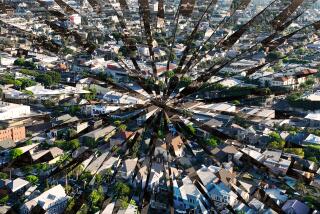What makes us shake, shiver, shudder
- Share via
EVER wonder why most of us are afraid of snakes or why we jump when there’s a loud noise? A new exhibition developed by the California Science Center explains that those reactions are among the many ways our brains and our bodies help keep us out of harm’s way.
“Goose Bumps! The Science of Fear” (not to be confused with R.L. Stine’s popular children’s book series, “Goose Bumps”) explores the ways our bodies respond to a perceived threat. Yes, it even explains goose bumps: The tiny body hairs that stand up are remnants from our hairier ancestral days when we “puffed up” to ward off predators.
“Fear is something we all experience but don’t necessarily understand, so this exhibit is really about helping people understand what fear is about from a scientific point of view,” says exhibit curator David Bibas. “We wanted to create something that was scary but fun, and we wanted to show how the brain and the body work together to generate physiological changes when we’re faced with danger.”
Beginning Wednesday, visitors to the new 6,000-square-foot exhibit will learn about this connection. In the challenge course, visitors can measure their responses to four common fears. In fear of animals, visitors reach into a black box connected to a terrarium containing live snakes, scorpions and cockroaches. In fear of electricity, visitors watch the spark rise on a Jacob’s ladder in anticipation of getting zapped. In fear of loud noises, a video camera records visitors’ reactions to a sudden noise; and in fear of falling, visitors experience a sudden loss of support.
Other displays demonstrate that fear is about keeping us alive. In “Freeze Game,” visitors are projected onto a screen, and they attempt to outwit a virtual leopard; in “Danger or No Danger?,” visitors have all of a second to determine whether a blurry image is a threat. “What the ‘Danger’ game shows is that we do make a kind of automatic response before we are conscious of it,” says Bibas, who also serves as the CSC’s curator for technology programs. “It’s better to mistake a stick for a snake than the other way around.”
In addition to the interactives, the exhibit also features a Fear Theater, a Fear Lab and a section called “Coping With Fear,” which includes an illustrated timeline of common fears for different stages of development, tips for adults to help children move past their fears, and video interviews with patients afflicted with obsessive-compulsive disorder, post-traumatic stress disorder and a variety of social phobias.
“Fear is an emotion that can save our lives, but at the same time, it has some negative sides and sometimes our response to fear gets so out of whack that it becomes dysfunctional,” Bibas says. “The interviews get out the message that these disorders are treatable and there is help out there.”
--
‘Goose Bumps! The Science of Fear’
Where: California Science Center, 700 State Drive, Los Angeles
When: Opens Wednesday. 10 a.m. to 5 p.m. daily. Closes Dec. 31.
Price: Free
Info: (323) 724-3623; www.californiasciencecenter.org


